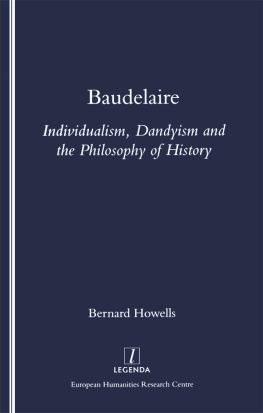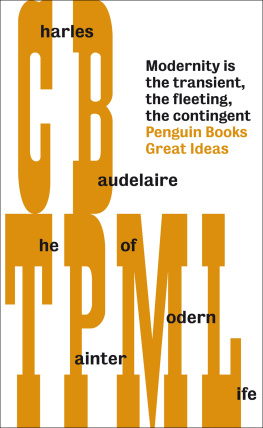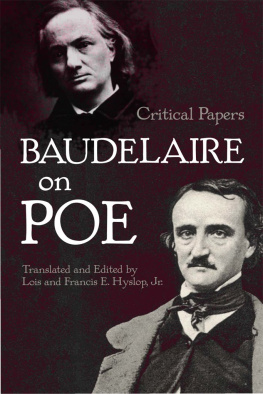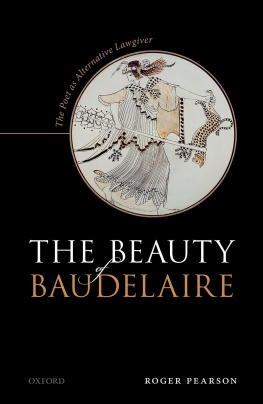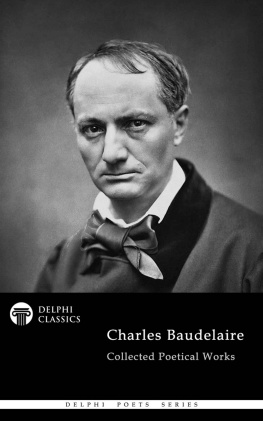Titles in the series Critical Lives present the work of leading cultural figures of the modern period. Each book explores the life of the artist, writer, philosopher or architect in question and relates it to their major works.
In the same series
Michel Foucault
David Macey
Jean Genet
Stephen Barber
Pablo Picasso
Mary Ann Caws
Franz Kafka
Sander L. Gilman
Guy Debord
Andy Merrifield
Marcel Duchamp
Caroline Cros
Frank Lloyd Wright
Robert McCarter
James Joyce
Andrew Gibson
Jean-Paul Sartre
Andrew Leak
Noam Chomsky
Wolfgang B. Sperlich
Jorge Luis Borges
Jason Wilson
Erik Satie
Mary E. Davis
Walter Benjamin
Esther Leslie
Jean Cocteau
James S. Williams
Georges Bataille
Stuart Kendall
Ludwig Wittgenstein
Edward Kanterian
Octavio Paz
Nick Caistor
Charles Baudelaire
Rosemary Lloyd
Charles Baudelaire
Rosemary Lloyd

REAKTION BOOKS
For Sandy Hamrick
Published by Reaktion Books Ltd
33 Great Sutton Street
London EC1V ODX, UK
www.reaktionbooks.co.uk
First published 2008
Copyright Rosemary Lloyd 2008
All rights reserved
No part of this publication may be reproduced, stored in a retrieval system, or transmitted, in any form or by any means, electronic, mechanical, photocopying, recording or otherwise, without the prior permission of the publishers.
Page references in the Photo Acknowledgements and Index match the printed edition of this book.
Printed and bound in Great Britain by Cromwell Press, Trowbridge, Wiltshire
British Library Cataloguing in Publication Data
Lloyd, Rosemary
Charles Baudelaire. (Critical lives)
1. Baudelaire, Charles, 18211867
2. Poets, French 19th century Biography
3. Art critics France Biography
I. Title
841.7
ISBN 13: 978 1 86189 363 5
Contents
Abbreviations
oc Charles Baudelaire, uvres compltes, ed. Claude Pichois and Jean Ziegler (Paris, 19756)
c Charles Baudelaire, Correspondance, ed. Claude Pichois (Paris, 1972)
MOP Charles Baudelaire/Thomas De Quincey, Un Mangeur dopium, ed. Michle Stuble (Neuchtel, 1976)
All translations are my own.
1
Childhood and Youth
A small medallion offers the earliest known picture of Charles Baudelaire. He is a collgien, poised between childhood and adolescence, at that eternal moment he was to describe some ten years later in a poem he sent to the poet, novelist and critic Sainte-Beuve:
All beardless then, on that old oaken bench,
More worn and polished than fetters on a chain,
Buffed through the endless day by flesh of men,
We sadly hauled our sorrows, cowerd and bent,
Beneath that square of sky where we knew solitude,
Where ten years long the child drinks studys bitter brew.
(oc, I , p. 206)
His gaze is wary, slightly resentful, the mouth unsmiling. In his first full-length article on his American alter ego, Edgar Allan Poe, Baudelaire would make the following claim:
All those who have reflected on their own lives, who have often
looked back to compare their past with their present, all those
who have adopted the habit of exploring their own psychology
with ease, know what an immense part adolescence plays in
an individuals ultimate originality. It is then that objects leave
their deep trace on the tender and uncomplicated mind. It is
then that colours are vivid and that sounds speak a mysterious
language. The character, the originality, and the style of an
individual are formed by the apparently commonplace circumstances
of early youth. If all those who have occupied the
worlds stage had noted their first impressions of childhood,
what an excellent psychological dictionary we would possess!
(oc, II , p. 253)
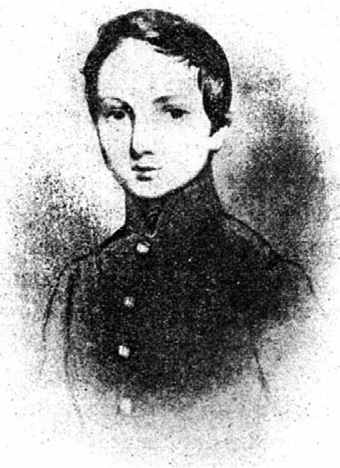
Baudelaire as a schoolboy, 1830, medallion.
The deep traces his childhood left on Baudelaires mind are an essential part of his creative genius and his personality, and in the little medallion they can be detected already at work on his image of the world.
We might wonder why there is no earlier portrait, no sketch left by his father, an amateur painter. But by 1819, when Franois Baudelaire married Caroline Defayis, he had reached that age when the pleasures offered by a young wife were doubtless far greater than those of raising a young child. After all, had he lived to see the first publication of Les Fleurs du mal, Franois Baudelaire would have been 98 years old. When the future poet was born, Franois Baudelaire already had a sixteen-year-old son by his first wife. Charless first seven years were spent with a father whose mind had been formed before the 1789 Revolution and a mother who, having married at the age of 26, must have felt she had barely escaped the grim fate the nineteenth century reserved for impecunious spinsters.
Looking back at his childhood when he came to put together some notes for a journalist seeking to write a brief biographical sketch, Baudelaire remembered the house in the rue Hautefeuille in Pariss Latin Quarter, with its medieval network of narrow, cobbled streets and grimy buildings. What the future promoter of the modern world would recall was how old-fashioned it all seemed. Old furniture from the period of Louis XVI [177493], he recalled, antiques from the Consulate [17991804], Pastels. The society of the eighteenth century (oc, I , p. 784). Despite the difference in their ages, however, Baudelaires father left at least one deep and permanent impression on his childs mind: the love of art. His great poem The Voyage, for instance, opens with the following stanza:
For the child enamoured of prints and maps
The universe is as vast as his vast appetite.
How immense is the world in the glow of the lamps!
To memorys gaze how it all seems trite! (oc, I , p. 129)
Baudelaire himself was a child enamoured of images, which he was later to designate as his great, unique, and primitive passion (oc, I , p. 701). As he indicates in a brief description of his life and works, his nature had been marked by a permanent taste, since childhood, for all images and all forms of representation in the plastic arts (oc, I , p. 785). His father, to whom, with that embellishment of the truth in which the poet frequently indulged when it provided the requisite degree of shock, he referred as a defrocked priest, had indeed been trained through the church and admitted to the priesthood in 1784. He preferred, however, a career as a teacher. An amateur painter as an adult, Charles Baudelaire would describe his fathers work as execrable but, characteristically, seek to preserve it and a skilled Latinist, Franois Baudelaire combined these gifts in his position as a tutor to the two young sons of the Duke de Choiseul-Praslin, creating for them an illustrated Latin word book. Among the many images in this vocabulary is one in which a boy whips a top (just as in The Voyage an angel whips the stars in the cosmos), while behind him are a globe of the earth and two prints, one of them a map of the two hemispheres. This is the immense world of childhood imagination, a plaything for a boy to set spinning, but doomed to shrink in adulthood into repetition and banality:



